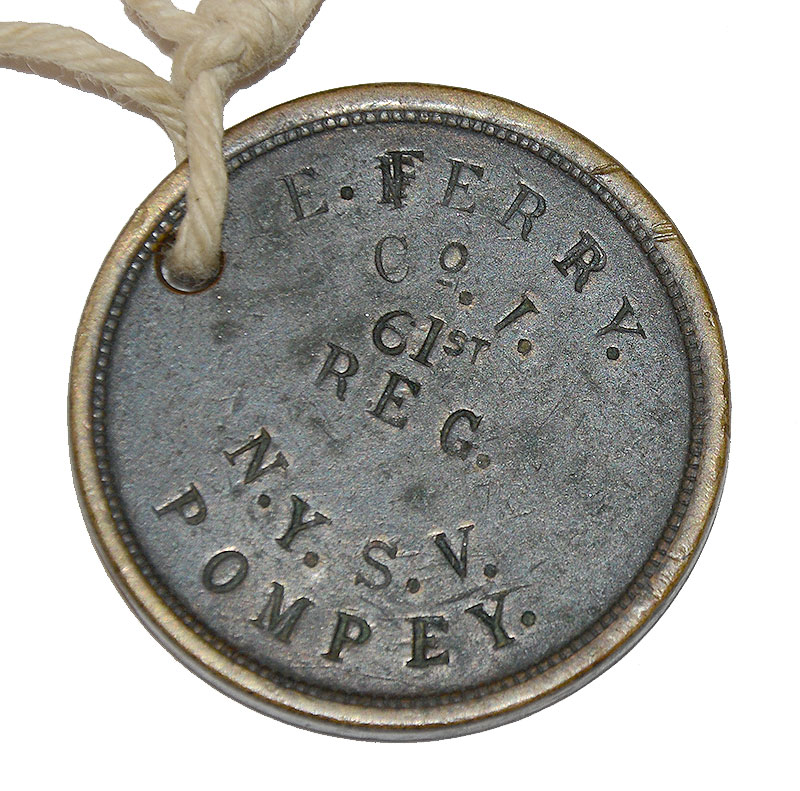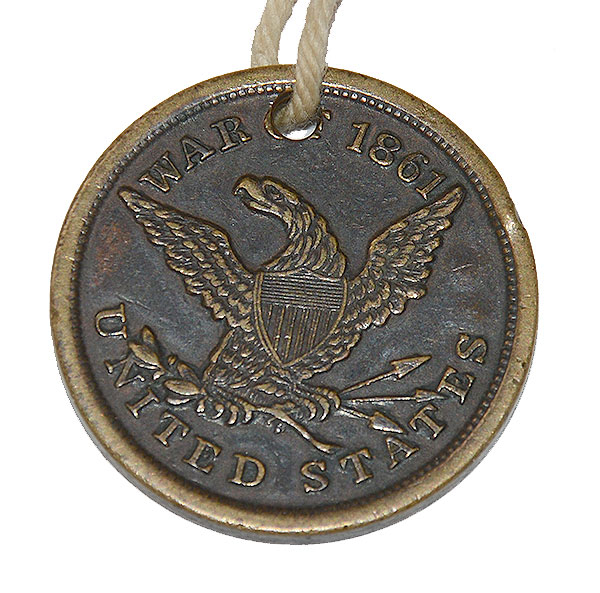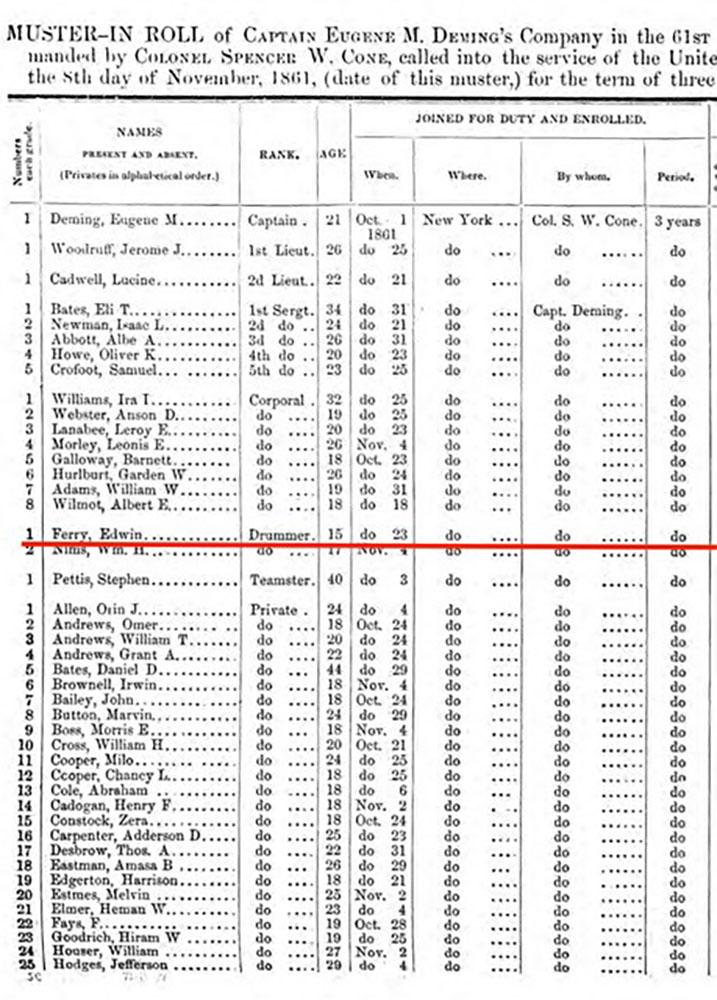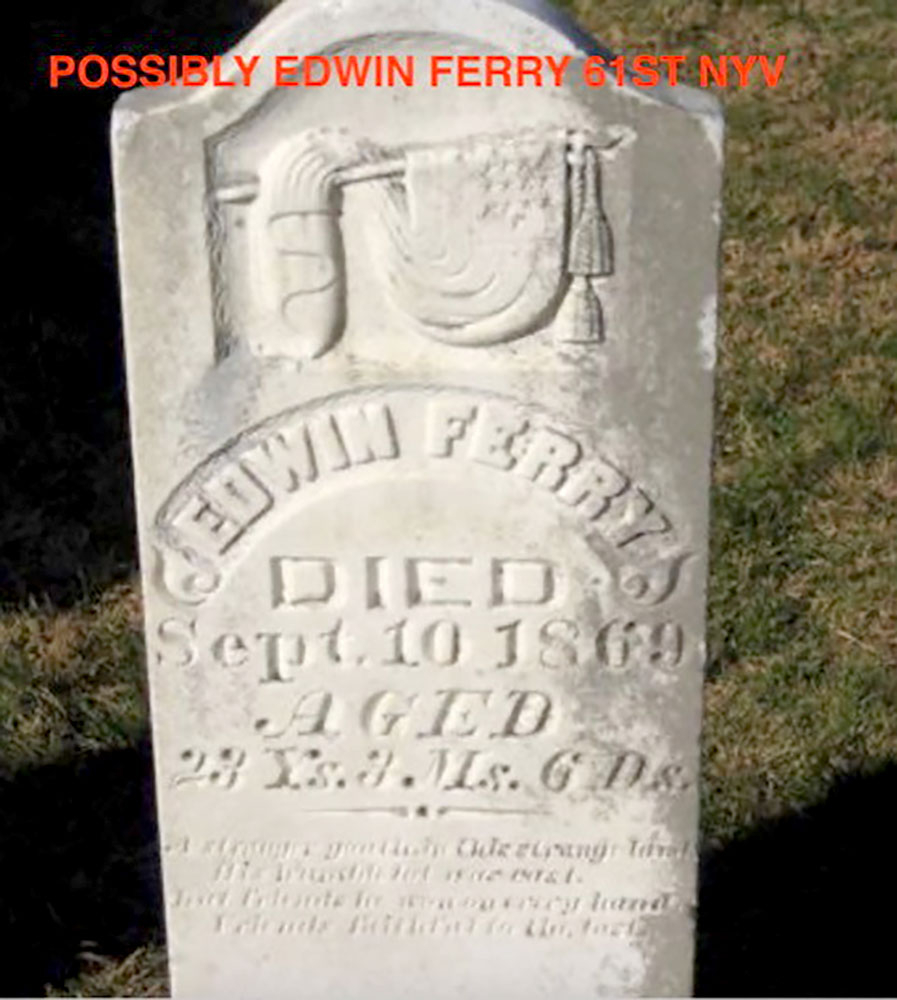site search
online catalog
“WAR OF 1861” EAGLE IDENTIFICATION DISK OF DRUMMER EDWIN FERRY 61st NEW YORK

Hover to zoom





$2,975.00
Quantity Available: 1
Item Code: 2025-3028
Shipping: Determined by Method & Location of buyer
To Order:
Call 717-334-0347,
Fax 717-334-5016, or E-mail
A very good example of a Civil War “Eagle / War of 1861” pattern identification disk worn by a young drummer from New York who saw some early service in the 61st New York, a very active regiment that counted among its Colonels Francis Barlow and Nelson Miles. Civil War soldiers had to provide their own methods of identification, with commercial suppliers offering a variety of stamped or engraved badges often in the form of medals or awards. This is pattern uses a brass disk, likely given a thin silver wash originally and pierced for suspension from a pinback top in the form of an eagle or portrait bust of a favorite general.
The disk shows the Arms of the U.S. on one side- an eagle with raised and spread wings, holding arrows and olive branch, with “WAR OF 1861” in raised letters in an arc at top and “UNITED STATES” at the bottom. The reverse was then personalized by the sutler or merchant selling it by stamping the reverse, in this case with the soldier’s name, unit, and hometown: “E. FERRY. / Co. I. / 61st / REG. / N.Y.S.V. / POMPEY.” The “F” was struck twice by the vendor and the Y and I are a tad light on the bottom, but everything is fully legible, and the tag preserves its darkened silver wash in the recesses around the eagle on the obverse and the entire face below the raised rim on the reverse, with muted, aged brass showing from rubbing on the raised rim and the highpoints of the raised letters and eagle on the obverse.
In Maier and Stahl’s typology this is #5A. They note three of this type from companies A and F of the 61st NY in their survey and illustrate two. Both show a similar placement of the suspension hole through the word “OF” on the obverse. The tag of a soldier in Company A also shows the same layout of personal information on the reverse and positioning relative to the suspension hole (M&S, p. 103 bottom.)
A collector’s tag with this indicates Ferry was a drummer, enlisted at age 15, was wounded in 1863, deserted from the hospital, and then notes him (or the hospital) as “unlocated.” This is partially correct. Our own research shows that he enlisted at age 15 in New York City on Oct. 23, 1861, and mustered into Co. I of the 61st as a musician (specifically a drummer on the muster roll) on Nov. 6, 1861, later transferring to Co. F on Sept. 12, 1862. This is confirmed by abstracts of the NY muster rolls. The tag gives his hometown as Pompey, NY, (in Onondaga County.) How or why he went to New York City from Pompey is unclear, but the Pompey town clerk’s register of Civil War soldiers includes him as a resident of Pompey, along with the note that he was an orphan. The latter is confirmed by the 1855 NY state census, which lists him at age 8 in the Onondaga County Orphan Asylum at Syracuse, where he had resided for three years.
The 61st had been organized at New York City in October 1861 by consolidation of the “Astor Rifles” and the “Clinton Guards,” with companies mustering in through November, during which time, however he got to the city, Ferry enlisted in Company I for three years as a musician, thereby missing, whether he knew it or not, a $50 bounty from the town of Pompey to those who signed up there.
The regiment left the state November 9, 1861, served at Washington for a time, where it became part of Howard’s Brigade of Sumner’s and then Richardson’s Division. It was credited with participation in some minor affairs at Manassas and at Bealton and Rappahannock Station in late 1861 and early 1862, with no casualties, before joining the Peninsula Campaign. It was present, again without casualties, in the Siege of Yorktown, but experienced a bloody introduction to combat in the second day’s fight at Fair Oaks on June 1, losing 7 officers killed or mortally wounded along with 42 enlisted men, and another 57 officers and men wounded, and 4 missing. In the Seven Days Battles from June 25 to July 2, they were engaged at Peach Orchard, Savage Station, White Oak Bridge, Glendale and Malvern Hill, losing another 117 officers and men in killed, wounded and missing. By the time of they fought at Antietam they had been organized into just three companies for field service.
The Pompey Town Clerk’s record mentions his service in the Seven Days Battles, but not Fair Oaks. This could be an omission, but Ferry himself may have supplied the information, which would imply he was not at Fair Oaks. His muster roll abstract indicates he transferred to Company F on Sept. 12, 1862. This was just five days before Antietam, where the regiment helped break the Confederate line at Bloody Lane, but the Town Clerk’s register omits that also and we find a July 15, 1862, newspaper notice listing him among wounded and sick troops who had arrived in New York City aboard the “State of Maine,” with the New York soldiers apparently being sent to “College Hospital” in Brooklyn.
He seems to have remained in the hospital until October, when he simply left of his own accord. The muster roll abstract says only dates it to October and notes he deserted “From Hosp at the north.” The NYAG report only gives October 15, 1862, as the “estimated” day he deserted. Thereafter he falls from sight, though he may have returned to Pompey at least for a time. The clerk’s record says, “Discharged. Sent home by officers of the Regt.” Needless to say, that hardly qualifies as an official muster-out from the regiment, though he was sick and that one of his officers told him simply to go home, may well be true. That it made its way in that form into the town clerk’s register back in Pompey suggests it was Ferry himself who told them that version of his service history.
This is identification disk with an interesting story attached to it, that might well be filled out by some further sleuthing. We make only the following additional notes. Ferry does not appear in the 1890 veteran pension list, so he might simply have not tried to get one given his record, and even have changed his name in the meantime, if he was afraid his record as a deserter might catch up with him. We do, however, find a possible conclusion to the story. The Nebraska Dept. of the G.A.R. list of Civil War veterans buried in Nebraska records an Edwin Ferry, buried in Rosewood Cemetery, in Palmyra, Otoe County, who was born June 6, 1846, which would match our drummer, and died Sept. 10, 1869 (of Typhoid by one newspaper account.) The GAR card notes: “G.A.R. emblem on grave but no record available.” We do not guarantee this identification with the Edwin Ferry of the identification disk, but it seems a possibility. An online photo of the gravesite does not show a G.A.R. emblem, but his headstone is very clearly carved with a US flag and flag cords draped around a horizontal staff. If this is our Edwin Ferry, it is a suitable monument for a boy, likely adrift in the world as an orphan, who answered his country’s call and saw some bloody action on the Peninsula in 1862, even if he did not serve out his full term. [sr][ph:L]
~~~~~~~~~~~~~~~~~~~~~~~~~~~~~~~~~~~
THIS ITEM, AS WITH ALL OTHER ITEMS AVAILABLE ON OUR WEB SITE,
MAY BE PURCHASED THROUGH OUR LAYAWAY PROGRAM.
CLICK HERE FOR OUR POLICIES AND TERMS.
THANK YOU!
Inquire About “WAR OF 1861” EAGLE IDENTIFICATION DISK OF DRUMMER EDWIN FERRY 61st NEW YORK
Most Popular
Historical Firearms Stolen From The National Civil War Museum In Harrisburg, Pa »
Theft From Gravesite Of Gen. John Reynolds »
Selection Of Unframed Prints By Don Troiani »
Fine Condition Brass Infantry Bugle Insignia »
Large English Bowie Knife With Sheath 1870’S – 1880’S »
Imported (Clauberg) Us Model 1860 Light Cavalry Officer's Saber »
featured item
EARLY WAR U.S. CAVALRY OFFICER’S SABER, 1840 STYLE, BY SMITH, CRANE AND COMPANY, NEW YORK, 1858 TO 1862
Smith, Crane and Company pieces are scarce. They were only in business from 1858 through 1862, retailing military goods in New York City. Their swords were imported, of German make and likely by Schnitzler and Kirschbaum, though not maker marked.… (870-263). Learn More »


